![]()
![]()
![]()
Use LEFT and RIGHT arrow keys to navigate between flashcards;
Use UP and DOWN arrow keys to flip the card;
H to show hint;
A reads text to speech;
54 Cards in this Set
- Front
- Back
- 3rd side (hint)
|
Abiotic factor
|
A non-living, physical factor that may influence an organism or ecosystem.
|
For example, temperature, sunlight, pH, salinity, precipitation.
|
|
|
Biodiversity
|
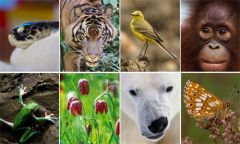
The amount of biological or living diversity per unit area. It includes the concepts of species diversity, habitat diversity and genetic diversity.
|
|
|
|
Biomass
|
The mass of organic material in organisms or ecosystems, usually per unit area. Sometimes the term "dry weight biomass" is used where mass is measured after the removal of water. Water is not organic material and inorganic material is usually relatively insignificant in terms of mass.
|
Sometimes the term "dry weight biomass" is used where mass is measured after the removal of water. Water is not organic material and inorganic material is usually relatively insignificant in terms of mass.
|
|
|
Biome
|

A collection of ecosystems sharing similar climatic conditions; for example, tundra, tropical rainforest, desert.
|
|
|
|
Biosphere
|
That part of the Earth inhabited by organisms, that is, the narrow zone (a few kilometres in thickness) in which plants and animals exist.
|
It extends from the upper part of the atmosphere (where birds, insects and windblown pollen may be found) down to the deepest part of the Earth's crust to which living organisms venture.
|
|
|
Biotic factor
|
A living, biological factor that may influence an organism or ecosystem.
|
For example, predation, parasitism, disease, competition.
|
|
|
Carrying capacity
|
The maximum number of a species or "load" that can be sustainably supported by a given environment.
|
|
|
|
Climax community
|
A community of organisms that is more or less stable, and that is in equilibrium with natural environmental conditions such as climate; the end point of ecological succession.
|
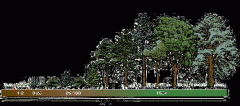
|
|
|
Community
|

A group of populations living and interacting with each other in a common habitat.
|
|
|
|
Competition
|
A common demand by two or more organisms upon a limited supply of a resource
|
For example, food, water, light, space, mates, nesting sites.
It maybe infraspecific or interspecific. |
|
|
Correlation
|
A measure of the association between two variables.
|
If two variables tend to move up or down together, they are said to be positively correlated. If they tend to move in opposite directions, they are said to be negatively correlated.
|
|
|
Diversity
|
A genetic term for heterogeneity. The scientific meaning of diversity becomes clear from the context in which it is used; it may refer to heterogeneity of species or habitat, or to genetic heterogeneity.
|
|
|
|
Genetic diversity
|
The range of genetic material present in a gene pool or population of a species.
|
|
|
|
Habitat diversity
|
The range of different habitats or number of ecological niches per unit area in an ecosystem, community, or biome.
|
|
|
|
Diversity index
|
A numerical measure of species diversity that is derived from both the number of species (variety) and their proportional abundance.
|
|
|
|
Species diversity
|
The variety of species per unit area. This includes both the number of species preset and their relative abundance.
|
|
|
|
Ecosystem
|
A community of interdependent organisms and the physical environment they inhabit.
|
|
|
|
Entropy
|
A measure of the amount of disorder, chaos, or randomness in a system; the greater the disorder, the higher the level of entropy.
|
|
|
|
Environmental impact assessment (EIA)
|
A method of detailed survey required, in many countries, before a major development.
|
|
|
|
Equilibrium
|
A state of balance among the components of a system.
|
|
|
|
Feedback
|
The return of part of the output from a system as input, so as to affect succeeding outputs.
|
|
|
|
Negative feedback
|

Feedback that tends to damp down, neutralise or counteract any deviation from an equilibrium, and promotes stability.
|
|
|
|
Positive feedback
|
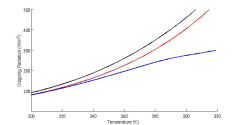
Feedback that amplifies or increases change; it leads to exponential deviation away from an equilibrium.
|
|
|
|
Gaia
|
The Gaia hypothesis (developed by James Lovelock and named after an ancient Greek Earth goddess) compares the Earth to a living organism in which feedback mechanisms maintain equilibrium.
|
|
|
|
Habitat
|
The environment in which a species normally lives.
|
|
|
|
K-strategist
|
Species that usually concentrate their reproductive investment in a small number of offspring, thus increasing their survival rate and adapting them for living in long-term climax communities.
|
Like elephants, humans, whales.
|
|
|
R-strategist
|
Species that tend to spread their reproductive investment among a large number of offspring so that they are well adapted to colonise new habitats rapidly and make opportunistic use of short-lived resources.
|
Like house flies, mosquitos, cockroaches.
|
|
|
Latitude
|
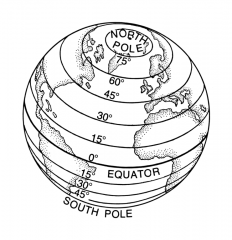
The angular distance from the equator (that is, north or south of it) as measured from the centre of the Earth (usually in degrees).
|
|
|
|
LEDC
|
Less economically developed country: a country with low to moderate industrialisation and low to moderate average GNP per capita.
|
|
|
|
MEDC
|
More economically developed country: a highly industrialised country with a high average GNP per capita.
|
|
|
|
Model
|
A simplified description designed to show the structure or workings of an object, system or concept.
|
|
|
|
Mutualism
|
A relationship between individuals of two or more species in which all benefit and none suffer.
|
|
|
|
Niche
|
A species' share of a habitat and the resources in it. An organism's ecological niche depends not only on where it lives but also on what it does.
|
The niche is a complete description of a species - where, when, and how it lives. Two species cannot share the same niche. Species with overlapping niches will compete with each other.
|
|
|
Parasitism
|
A relationship between two species in which one species (the parasite) lives in or on another (the host), gaining all or much (in the case of a partial parasite) of its food from it.
|
For example, a mosquito.
|
|
|
Population
|
A group of organisms of the same species living in the same area at the same time, and which are capable of interbreeding.
|
|
|
|
Gross productivity (GP)
|
The total energy or biomass gained per unit area per unit time, which would be through photosynthesis in primary producers or absorption/feeding in consumers.
|
|
|
|
Gross primary productivity (GPP)
|
The total energy or biomass gained by producers per unit area per unit time, through photosynthesis.
|
|
|
|
Gross secondary productivity (GSP)
|
The total energy or biomass gained by consumers per unit area per unit time, through feeding or absorption.
|
|
|
|
Net productivity (NP)
|
The energy or biomass gained per unit area per unit time remaining after allowing for respiratory losses.
|
|
|
|
Net primary productivity (NPP)
|
The energy or biomass gained by producers per unit area per unit time remaining after allowing for respiratory losses.
|
|
|
|
Net secondary productivity (NSP)
|
The energy or biomass gained by consumers per unit are per unit time remaining after allowing for respiratory losses.
|
|
|
|
Primary productivity
|
The energy or biomass gained by producers per unit area per unit time.
|
|
|
|
Secondary productivity
|
The energy or biomass gained by consumers per unit area per unit time, through feeding and absorption.
|
|
|
|
Sere
|
The set of communities that succeed one another over the course of succession at a given location.
|
|
|
|
Society
|
An arbitrary group of individuals who share some common characteristics such as geographical location, cultural background, historical timeframe, religious perspective, value system, and so on.
|
|
|
|
Stable equilibrium
|
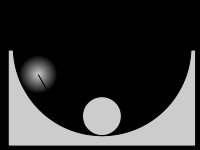
The condition of a system in which there is a tendency for it to return to a previous equilibrium condition following disturbance.
|
|
|
|
Steady-state equilibrium
|
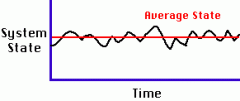
The condition of an open system in which there are no changed over the longer term, but in which there may be oscillations in the very short term. There are continuing inputs and outputs of matter and energy, but the system as a whole remains in a more or less constant state.
|
For example, a climax ecosystem.
|
|
|
Succession
|
The directional change in a community of organisms over time.
|
|
|
|
System
|
An assemblage of parts and the relationships between them, which together constitute an entity or whole.
|
|
|
|
Closed system
|
A system in which energy, but not matter, is exchanged with its surroundings.
|
|
|
|
Isolated system
|
A system that exchanged neither matter nor energy with its surroundings.
|
|
|
|
Open system
|
A system in which both matter and energy are exchanged with its surroundings.
|
For example, natural ecosystems.
|
|
|
Trophic level
|
The position that an organism occupies in a food chain, or a group of organisms in a community that occupy the same position in food chains.
|
|
|
|
Zonation
|
The directional change in a community of organisms over a distance.
|
The arrangement or patterning of plant communities or ecosystems into parallel or sub-parallel bands in response to change, over a distance, in some environmental factor. The main biomes display donation in relation to latitude and climate. Plant communities may also display donation with altitude on a mountain, or around the edge of a pond in relation to soil moisture.
|

